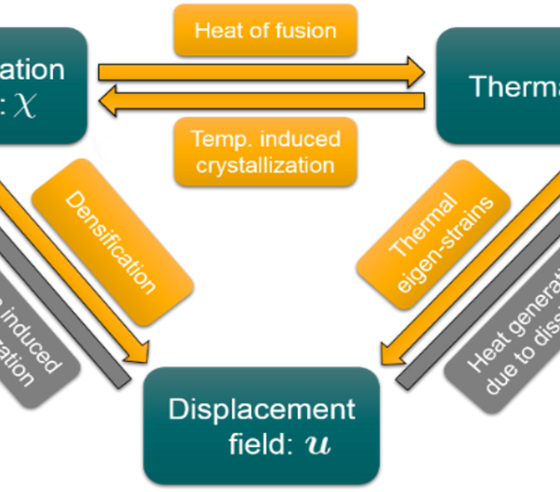Multi-scale Data-Physics Models for the Critical Role of Interfaces in Over-molded Thermoplastic Parts


In diverse industrial sectors such as automotive, aeronautics, energy, and biomedical applications, the necessity of joining dissimilar polymer layers is pervasive. One promising technique involves the sequential process of thermoforming a thermoplastic fiber reinforced laminate followed by overmolding it with a short fiber reinforced semicrystalline polymer. However, achieving durable adhesion between these layers poses a significant challenge, potentially leading to part failure and overdesign.
This project endeavors to address this challenge by delving into two pivotal aspects:
-
Complexity of Manufacturing Behavior: The behavior of manufactured parts is governed by multifaceted spatial and temporal scales, coupled with plenty of process-morphology parameters. A comprehensive understanding of how these factors interact is imperative for enhancing the performance of overmolded components.
-
Physics of Interfacial Bonding: The bonding process between thermoplastic layers involves heating the surfaces above the polymer’s melting point while maintaining a predominantly solid state. Critical processes encompass heat transport, interdiffusion, and co-crystallization.
The project's focal points include:
-
Development of a cohesive zone-based interface element tailored for bonding and debonding phenomena.
-
Integration of temperature dependence and jumps into the interface element to accurately simulate real-world conditions.
-
Formulation of a constitutive model for semicrystalline polymers, encompassing considerations of temperature, strain rate, and crystallinity.
-
Examination of the impact of fiber reinforcement on the overall performance and behavior of the overmolded components.
By unraveling the underlying physics and leveraging advanced modeling techniques, the project aims to optimize thermoplastics over molding processes. This endeavor seeks to empower manufacturers with the ability to predict and regulate interfacial properties, thereby facilitating the production of high-performance composite materials tailored to diverse industrial applications.
Funding
German Research Foundation (DFG)
U.S. National science foundation
International cooperations
Contact
